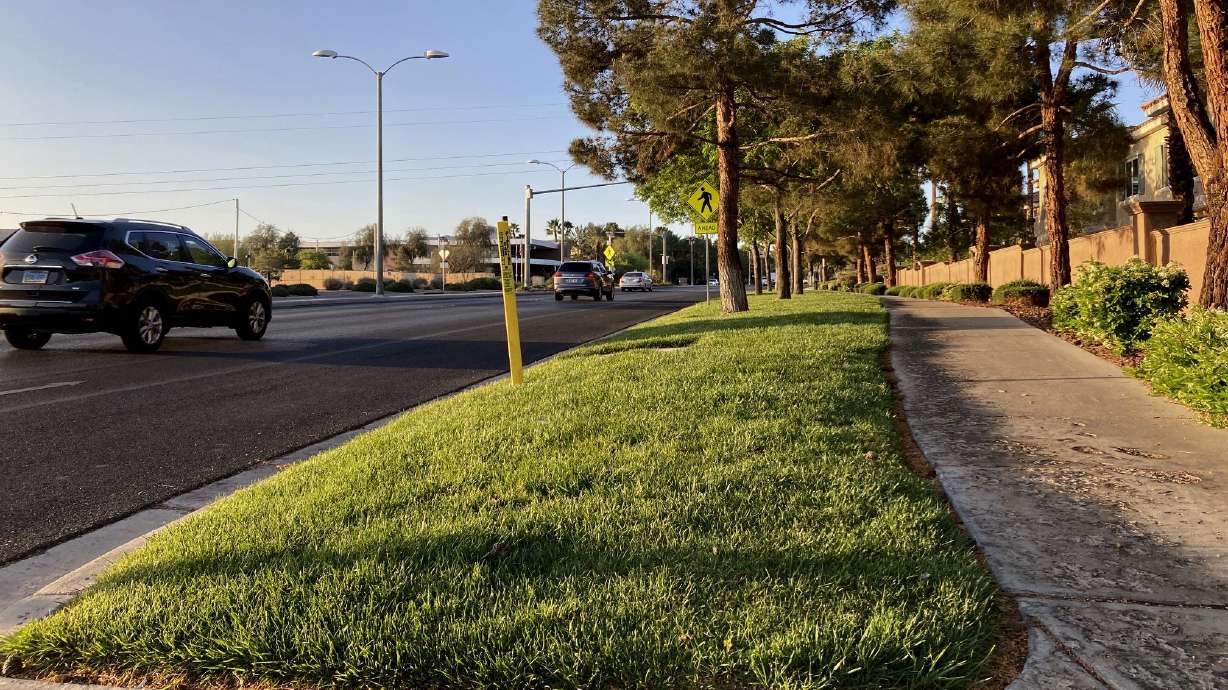Estimated read time: 4-5 minutes
This archived news story is available only for your personal, non-commercial use. Information in the story may be outdated or superseded by additional information. Reading or replaying the story in its archived form does not constitute a republication of the story.
This article is published through the Great Salt Lake Collaborative, a solutions journalism initiative that partners news, education and media organizations to help inform people about the plight of the Great Salt Lake—and what can be done to make a difference before it is too late. Read all of our stories at greatsaltlakenews.org.
SALT LAKE CITY — By 2027, more than 5,000 acres of what is deemed useless or simply ornamental turf will be ripped out of the Las Vegas Valley in what is the nation's first outright prohibition of turf in certain areas.
News outlets are reporting that by doing so, the region will cut its consumption of the dwindling Colorado River by 10% or more.
The move, a result of a law passed last year in Nevada, will ultimately result in 30% of the 13,000 acres of this "ornamental" grass being ripped out in the Las Vegas Valley.
Park strips, roundabouts, turf in roadway medians, areas at commercial outlets and at entrances to housing developments are all subject to the ban.
The prohibition, however, does not impact individual homeowners who can still opt into a voluntary program established in 1999. The compensation provided per square foot of turf removal is $3 in the Las Vegas Valley.
Since its inception, the program has resulted in 4,500 acres of grass being removed.
Southern Nevada residents also have their streets patrolled by the water police.
Courtney Brown, conservation programs manager for the Jordan Valley Water Conservation District in Utah, worked as a water cop in daily shifts that began at 1 a.m. and ended at 10 a.m. while living in the area.
"For finding water waste, that time for that shift was ideal," he said. "That is when the sprinklers are running."
Under cover of darkness, water users may be more inclined to skirt the rules because they think they will not be discovered.
Brown said the water police didn't hand out tickets or fines but delivered warnings that were then logged.
Subsequent "violations" resulted in a monetary penalty on the users' water bill, a sign of the water provider's seriousness over the issue.
Brown said such a program would be difficult in a state like Utah with so many different districts and water providers.
Jordan Valley, for example, has no land-use authority — that is left to individual cities that implement varying restrictions dependent upon political will.

This year, though, Utah became the first in the nation to implement a statewide turf buyback program. Cities can opt in for their residents, who can be compensated $1 per square foot of lawn strip removal or $1.25 if they take a class.
Brown said Jordan Valley and other districts have multiple conservation programs aimed at encouraging residents to replace park strips in particular.
During the Utah Legislature, a measure was approved to prohibit cities from requiring turf on areas less wide than 8 feet.
Additionally, lawmakers approved a measure that any state facility or "reconstruction" of a state facility after May of this year could have no more than 20% of its landscaped area made up of turf.
Certain exceptions apply, such as parks or sporting fields and agencies also have to report their annual water savings.
Such moves like these are important in a state like Utah, which gets 90% of its water from the snowpack. And of the treated municipal and industrial water consumption, 70% of that is used for outdoor irrigation.
Utah, like the rest of the West, is grappling with an unprecedented drought that has gripped the region for two decades.
Not only has the drought resulted in shortages on the Colorado River, but less water is making it to the Great Salt Lake, which contributes $1.4 billion annually to Utah's economy via the industries it supports, tourism and its unique ecosystem supporting hunters and nature lovers.
Multiple pieces of legislation — what Utah Gov. Spencer Cox described as a "generational" effort — are aimed at helping the largest saltwater lake in the Western Hemisphere survive. The lake dropped to its lowest historic level last year and is expected to diminish even further this year.
Water managers are hopeful that conservation strategies such as flip your strip and growing awareness over water-wise landscaping will help keep more water in the system — not only on a statewide basis but in particular for those waterways that feed into the Great Salt Lake.
The trick, they emphasized, is getting people to give up their love affair with lush lawns in a state in which 100% of its land is in some form of drought. Last year, the Utah Division of Water Resources had an aggressive campaign recognizing brown lawns are a badge for boasting rights and not indicative of someone's landscaping abilities. Some residents took it on, sporting signs in their yards.
To share your feelings about the Great Salt Lake, you can take this survey offered by the Great Salt Lake Collaborative.









